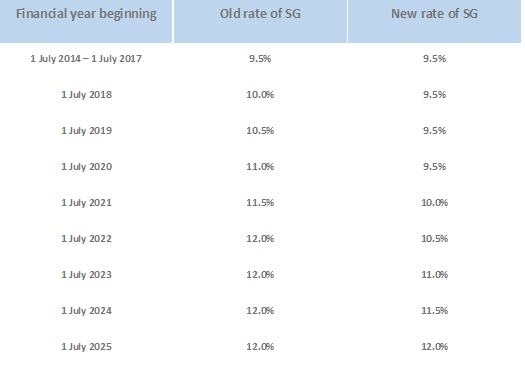Superannuation guarantee delayed until 2021
Legislation was passed in September 2014 that will slow down the increase in the rate of Superannuation Guarantee from 9.5% to 12% by three years. The first incremental increase from 9.5% to 10% was scheduled to take place on 1 July 2018, but this has now been delayed until 1 July 2021. This means that the full 12% will not apply until 1 July 2025 (previously 1 July 2022).
The following table shows the old and new Superannuation Guarantee rates:
A new Return to Work scheme for South Australia
From 1 July 2015 the existing WorkCover scheme will be replaced with the new Return to Work scheme.
The Return to Work scheme will save South Australian employers at least $180 million every year.
The focus of the Return to Work scheme is early intervention. This means if one of your employees has a work injury and requires time off work you will receive early, intensive and tailored support to assist their return to work.
The legislation also provides a number of improvements to the current WorkCover scheme for injured workers, including:
- the restoration of payments during disputes;
- improved strategies to equip workers who may not be in a position to return to their pre-injury
- employment to better compete for work in the open labour market;
- targeted return-to-work services as opposed to a one-size-fits-all approach;
- the creation of an employment facilitation fund to assist workers to develop skills, knowledge,
- capacity and capabilities that will enable them to transition to other work; and
- a dispute resolution process which will increase the speed at which disputes are heard and determined.
In 2015 WorkCoverSA will become ReturnToWorkSA and will be responsible for implementing and administering the Return to Work scheme.
More information regarding the changes will be provided to businesses early next year.
The legislation as passed is available here.
US Wine Industry Salaries up 5.4 percent in 2014
The results of the Wine Business Monthly’ s annual US Salary Survey as outlined in the Wine Business Monthly October 2014 edition, reveal a positive shift in wine industry salaries since one year ago. The salaries covered in the report increased overall by 5.4 percent in the last year, compared to 2.4 percent the year before. Additionally, 71.4 percent of all wine industry jobs showed an increase in pay compared to 56 percent the previous year.
Key findings include:
- Both categories of winemakers, across all winery sizes, saw 1 to 2 percent salary increases this year
- Vineyard Manager salaries saw a small increase this year
- Sales and marketing job posting were down by 18 percent as of June 2014 over the previous year
- Tasting Room Manager salaries continued an upward trend of increases since 2009 with this year’s average salary up 5 percent from the previous year
- While Office manager/supervisor and general administration job postings were up over the previous year, the average base salary had minimal increase.
For the full, comprehensive report, visit http://www.winebusiness.com/wbm/
Get the interview process right
Tips to make sure you invest in the right candidate for your business
Source: Grapegrower & Winemaker, November 2014, Stephanie Timotheou
What is your advice for people interviewing job candidates?
Christian Campanella, Pernod Ricard Winemakers’ global HR Director: My first piece of advice is to view the meeting as a two-way road. If you’re interviewing for a role, you should use this as an opportunity to glean information on the business, for example culture, values, business strategy, performance and so forth. If you are the interviewee, it’s good to show you have researched the role you are applying for and details about the business and the industry – try and find a way to seed questions on these topics. This demonstrates the depth of understanding and commitment of the potential candidate. Also, don’t be shy to ask a question about a new idea or innovation. It’s good to see the creativity of the interviewee coming across in the interview.
Lisa Morris, Hays recruitment’s senior regional director for SA: When interviewing for your next team member, it’s important to take the time to prepare questions that will allow you to determine who the best candidate for the job is.
Most interviewers start by asking a few general questions to get more of an idea about the candidate’s background. A specific question often asked is “why do you think you are qualified for this position?” Qualifications, in this context, mean everything that could make the candidate suitable for the position including educational, employment-related and personal qualifications.
Interviews then move on to experience. At this stage of the interview you are looking for details about relevant employment or other experience that relates to your industry, organisation, and the position itself.
Then it’s a good idea to ask a series of behavioural interview questions. Behavioural interview questions attempt to predict future behaviour based on the person’s past behaviour in a similar situation. You can also ask about the candidate’s career objectives or long term aspirations. This shows if the candidate is ambitious and has taken some action towards realising their ambitions. In some organisations, employers also ask candidates questions designed to test their ability in situations or crises.
Usually these revolve around the most common type of dilemma in the job you are interviewing the candidates for. If you ask the same list of questions to each candidate, it makes the interview fairer, more transparent and it can help organisations reduce the chance of making costly hiring mistakes.
Look out for more interview tips in upcoming Winejobs Knowledge Centre articles or visit www.winebiz.com.au/gwm for the full article.
New research shows ‘Job Lag’ is costing the economy six billion each year
Job Lag is costing the economy over six billion dollars each year due to poor recruitment practices and staff turnover cost close to 50 per cent of an annual salary, 20 per cent more than previously thought according to a new study. In response, a ‘world first’ program was launched today by the Assistant Minister for Employment the Hon Luke Hartsuyker to help new employees Hit The Ground Running and save Australian business millions of dollars in turnover costs.
Research released today, supports the launch of the world’s first employment program to help people from disadvantaged groups find jobs through employers who have committed guaranteed roles. The ‘Hit The Ground Running’ program (HTGR) by Job Futures was designed specifically to reduce Job Lag and provide an economic model that will assist disadvantaged Australians and the long term unemployed achieve sustained employment. The first candidates will graduate today with immediate employment opportunities in long term positions that offer real career paths.
The report author, Dr Tim Baker, says that the landmark new research shows that we have previously underestimated the costs associated with staff turnover and that without changing the way we recruit people, we could have one of the least productive workforces in the world. Baker, who is an employment academic, published the paper today in conjunction with Job Futures, Australia’s largest Not-For-Profit (NFP) member organisation of Government employment services providers. “We need to change the way we train, induct and support new employees or businesses will fail to meet not only the employment needs of their companies and industries but also struggle to compete in a worldwide marketplace.”
The new research looks at employment practices and provides leadership for Australian business. No previous research has been done within the Australian context across all sectors. The research has also led to the creation of a new cost model to calculate the total costs of staff turnover, which until now had underestimated the scale of the issue because previous models were incomplete. The new model is called ‘Job Lag’.
Key findings of the report:
- Job Lag until now has been a largely intangible cost to business of a replacement employee reaching optimal productivity. Optimal productivity in this context can be defined as the point at which an employee is fully contributing the level of output that is expected of an established worker in that role.
- The calculated financial burden of Job Lag is costing Australian business six billion dollars per year and an average of $38, 833 per employee or 51 per cent of the annual wage.
- The new model of measuring Job Lag is a significant step forward in calculating the costs of staff turnover which until now, was only estimated at being one third of an employee’s wage and had never had an Australian context.
- There are seven tangible and six intangible costs associated with employee turnover. Tangible costs of employee turnover are: screening, interviewing, testing, wages, training, orientation and technology. Intangible costs of employee turnover are productivity loss, a new employee learning curve, increased supervision, intermediate costs during the recruiting process, increased stress on remaining employees resulting in decreased productivity, and the employee’s reduced productivity immediately prior to his or her (in) voluntary termination.
- Apart from a new employee’s background, other critical variables included in the cost of Job Lag are the industry and the size of the organisation, the reasons for termination, the capabilities, aptitude, support and the nature of the work itself are additional factors influencing optimal productivity.
- The research paper highlights the benefits of good induction training to offset the high levels of vulnerability of a new employee during the first few weeks of their new job to reduce Job Lag and reveals the impact of poor induction training that increases the risk of turnover and costs.
- By redressing the current underestimation of the size of the Job Lag problem as a key factor in the costs of employee turnover, businesses may start to change the way in which they both calculate the costs of employment issues and change employment practices to reap the benefits.
- A change in employment practices to reduce costs will increase productivity and profitability. This scenario will benefit new employment and retention rates, which is good for individuals, communities, and the economy.
- To calculate Job Lag: The period of time from notice of termination to actual termination + the time it takes to replace the terminated employee + the origins of the replacement employee + the time it takes for the new employee to reach optimal productivity = Job Lag.
- The Hit the Ground Running program was specifically designed through research to reduce Job Lag amongst the groups that have the highest rates of Job Lag. They especially work with hardest hit groups in the unemployment race and give them the skills, integration, acclimatisation, mentoring and support from long before they take up roles to long after they have been employed. The fact that these practices are being used to help organisations that face high turnover and associated Job Lag in an effort to reduce costs is a significant first for the industry and the country as a whole. It should and will become the best practice model for employment in these industries.
Research paper: Job Lag, The Costs To Australian Employers Of Reaching Optimal Productivity For Semi-Skilled Workers by Dr Tim Baker, 2014, Brisbane Australia: Pages 16. A downloadable copy of the paper can be found here (only available under embargo until 5th November) or by going to the job Futures website www.jobfutures.com.au or www.hitthegroundrunning.com.au
About Job Futures: Job Futures is Australia’s only national network of community based, Not-For-Profit (NFP) organisations and are one of the country’s largest providers of employment, training, disability and welfare services. Dedicated to changing lives and strengthening communities, we assist over 52,000 disadvantaged Australians annually and place around 40 people into work each day through our Five Star rated services.
For further details contact:
Stieve De Lance, Tel: 0431 139 681, Sdelance@reputationaustralia.com.au
Interview opportunities: Report author, Dr Tim Baker, Matt Little, CEO Job Futures
CEOs call for focus on equal pay as gender reporting data exposes widespread inaction
New data released on the 29th of September 2014 by the Workplace Gender Equality Agency (WGEA) shows almost three quarters of Australian employers haven’t taken steps to ensure they pay women and men fairly. 73.7% of organisations have never done a gender pay gap analysis, and less than one in five have done a gender pay gap analysis in the past 12 months. MORE
Source: Workplace Gender Equality Agency
The Looming Talent Crisis: Research Shows Companies Unprepared for Future of Work
New Study by Oxford Economics and SAP Finds Companies Lack Strategy and Solutions to Engage and Manage an Increasingly Global, Diverse and Contingent Workforce. MORE
Source: Virtual-Strategy Magazine
Pre-employment screening can help you avoid hiring the wrong candidate

By Aoife Gallagher-Watson, CBP Lawyers (Source: Australian Forests & Timber News, November 2014)
PRUDENT EMPLOYERS can conduct checks of a candidate’s references, qualifications, police/criminal background, litigious conduct and credit history prior to making a job offer. However, it is important to ensure that your screening process complies with the Australian Privacy Principles, anti-discrimination legislation and state laws.
Pre-employment screening (PES) is a due diligence process conducted by vigilant employers prior to making a job offer to a potential candidate. The process is essentially an investigation conducted by an employer with a view to verifying a job applicant’s background and the validity of his/her skills, qualifications and experience as asserted in their job application.
Hiring the wrong candidate can lead to a plethora of future problems for an employer, ranging from minor issues such as wrong fit or inadequate performance (resulting in a short lived employment relationship and repeated recruitment costs), to more serious problems such as fraud, damage to reputation or even litigation.
Furthermore, given the protections now available to employees, it is especially beneficial to be aware of any of these potential problems prior to making any job offer.
Information uncovered during background checks can include:
- Historical job commitment (or lack thereof)
- Integrity of the candidate – were the alleged qualifications and experience claimed by the job applicant valid or misrepresented?
- Litigation history – in a recent case where an employee made a vexatious claim against their employer, it was discovered that they had a history of making similar claims against previous employers
What screening processes do companies run?
- Reference check – a standard reference check phone call will ordinarily provide a sincere and realistic view of a potential candidate
- Qualification check – documentary evidence can be used to verify qualifications and accreditations quickly
- Mandatory requirements – some jobs require mandatory checks specific to that role. However, nearly all jobs will require an employer to ensure that a job applicant has a legal right to work in Australia
- Police/criminal background check – will disclose the existence of a criminal record
- Civil/criminal litigation check – by conducting a public case law search, you may uncover a history of litigious conduct or previous contractual breaches that have the potential to harm your business
- Bankruptcy and credit history checks can give a useful indication of a candidate’s levels of responsibility and reliability
- ASIC Register – a quick search of the ASIC Register will disclose whether someone has been deemed a banned/disqualified person
Obtaining consent from the candidate prior to conducting searches
Any employer or business intending to conduct PES must be aware that legal and ethical considerations apply both prior to conducting any searches and when taking any information uncovered into account in making your decision on the successful candidate. First and foremost, consent from the candidate should be obtained prior to conducting any searches. This might be included on a job application form or requested following an interview, for example.
Complying with the Australian Privacy Principles
Secondly, issues surrounding data protection, privacy and discrimination need to be addressed. The privacy element is especially important considering that changes to privacy laws in Australia were implemented in March 2014.
The new Australian Privacy Principles require an individual about whom information is being collected to be informed of certain things, such as the fact that the information is being collected and who is collecting the information. For more information see the website of the Office of the Australian Information Commissioner.
Complying with Australian anti-discrimination law
Another important issue to bear in mind when conducting (or considering) PES checks is Australian anti-discrimination law. Of particular importance is the Australian Human Rights Commission Act 1986, which applies to employers and employees concurrently with state and territory legislation.
Where the discovery of a criminal record results in a person being discriminated against because of that record (including circumstances where a job applicant is refused employment where a criminal record is revealed), a company may leave itself open to discrimination claims.An exception arises where the conviction in question would impact directly on the job. However, it must be noted that some state-specific variations do arise in state anti-discrimination statutes. The Australian Human Rights Commission has developed a set of guidelines that can provide assistance to employers in navigating their way around this issue. The same applies to a dismissal for discovery of a conviction. However, where an employee has misrepresented himself or herself during the recruitment process, there may be cause for termination.
What happens when the screening process uncovers unfavourable information?
Should a PES check produce a result that gives you any reason for concern, it is advisable to discuss its relevance to that role and/or your potential liability in the event that you need to refuse a candidate based on same with your lawyer. He/she can also assist in determining the legality of any PES policy that you may have in place. Due to the variations in state laws, local guidance in this regard can be particularly beneficial.
Launch of Safe Work Australia Month
On the 1st of October the Minister for Employment and Safety Ambassador Senator Eric Abetz officially launched Safe Work Australia Month and its feature event, the new Australian Strategy Work Health and Safety Virtual Seminar Series.
The Virtual Seminar Series, to be held through Safe Work Australia Month in October, is a free online programme that will showcase the latest thinking, developments and research in work health and safety.
The series will include presentations from national and overseas work health and safety experts, discussions with business leaders and live online panels.
In officially launching Safe Work Australia Month, Senator Abetz said the Virtual Seminar Series was a terrific way to get workers, businesses and the community to learn more about work health and safety.
Senator Abetz’s video message can be accessed here:http://www.safeworkaustralia.gov.au/sites/swa/media-events/safety-month/pages/swam
“Safe Work Australia Month and the Virtual Seminar Series provide individuals, businesses and the general community with a platform to start a conversation about work health and safety,” Senator Abetz said.
“Raising awareness of work health and safety will reduce injuries, increase productivity and may save a life.
“Sadly, 191 people lost their lives in a work-related incident in 2013.
“While this is the lowest number on record, it’s still 191 too many.
“It’s important for all businesses – no matter their size – to effectively manage the health and safety of their workers.
“That’s why the Australian Government is working towards ensuring straightforward and easy-to-understand work health and safety guidance so that everyone can understand what they need to do.
“So, this October, I encourage everyone to make work health and safety a priority, take part in the Virtual Seminar Series and become a safety leader by getting involved in Safe Work Australia Month.”
More information about the full range of Safe Work Australia Month events being held during October is available by downloading the free Safe Work Australia Month app.
For further information about how you can get involved in Safe Work Australia Month, visit www.swa.gov.au
Résumé writing: Stand out from the crowd
By Stephanie Timotheou, Source: Australian & New Zealand Grapegrower & Winemaker, October 2014
Grapegrower & Winemaker journalist, Stephanie Timotheou, got the scoop from Treasury Wine Estate’s Cameron Fitzgerald and CozWine’s Ryan Dahlitz on all there is to know about presenting the perfect résumé.
At a glance:
• The perfect résumé should include fundamental information such as your career objective, employment history, training and education and at least three referees.
• Keep your résumé between three and five pages.
• List any hobbies or sporting activities to give the reader an idea of the sort of person you are away from the office.
• Avoid using graphics or fancy layouts as this can distract the reader and looks unprofessional.
• Your potential employer will spend between 30 and 60 seconds scanning your résumé so it’s important to ensure the formatting is simple and easy to follow.
A RÉSUMÉ is the first point of contact an employer has with you and is used to sell yourself in the corporate world. That’s why it’s important to ensure it gives the reader a clear idea of the sort of person you are, what you hope to achieve throughout your career and the training and education you’ve had to help get there.
According Ryan Dahlitz, from wine recruitment firm CozWine, a résumé should highlight your experience, qualifications and skills, organised in a way that’s easy to understand and follow.
While it may seem obvious to some, Dahlitz recommends including your full name and contact details to ensure an employer can get hold of you if they are interested to find out more. Your fixed address, correct phone numbers (landline and mobile) and email address should be listed at the top of the page for quick and easy access. Other important things to list while keeping it clear and concise are:
- Your career objective: This tells potential employers the sort of work you are hoping to do. Dahlitz suggests being specific and realistic about what you want and tailor the objective to suit each employer or to target the role you are applying for;
- Your employment history: Start from the most recent job and work backwards. Include the title of the position, the name of the organisation and the location. Describe your work responsibilities with an emphasis on specific skills and achievements;
- Your education and training: Name the institution or training provider, the resulting qualification or skills obtained and the date the qualification was obtained or when the training occurred;
- References: Dahlitz suggests listing at least two referees along with their contact details; and
- Additional information: This includes memberships for professional institutes, organisations you are a member of (volunteer work or sporting clubs etc.) and specific licences or permits applicable to the industry.
When listing your employment history, a summary of responsibilities and tasks performed is only recommended for the past 7-10 years. Any relevant positions held after this period should be listed without explanation. Dahlitz says if additional information is required for these positions, a brief summary (2-3 lines maximum) is acceptable. In most cases you only have seconds to catch the reader’s attention before they move on to the next applicant, so the words you use and how you present them are critical. To set yourself apart from competitors, Dahlitz suggests the following:
- Use headings, bullet points and sub-headings to allow the reader to scan your résumé;
- Include a cover letter and highlight in bold any specific skills and qualifications you want to catch the reader’s eye. You could also use this method in your résumé, but not too often; and
- Continuously update your information to ensure you haven’t left anything important out.
Cameron Fitzgerald, Treasury Wine Estate’s (TWE) lead careers business partner, manages the company’s recruitment function which provides support for Australia, New Zealand, Asia and Europe. He scans anywhere between 20 and 300 applications per job vacancy, depending on what the role is and where it’s located. When asked what he looks for in the perfect résumé, Fitzgerald said it is important to capture the employer’s attention at a first glance. “It must be clear and concise and must also have a bit of white space, not an abundance of text on a page. You don’t want the message to get lost” he says. When recruiting, Fitzgerald particularly looks for résumés that point to the candidate’s achievements more-so than responsibilities. “We want to see a clear snapshot of how someone may have progressed in their career,” he says. “We also want a quick, concise view of how they can move through roles and once we’ve made that initial assessment, we start looking for the person who’s got a clear understanding of the business or industry and someone who’s done their research on the job they’re applying for.”
Another thing he looks for is the way a candidate communicates, which he says a recruiter can pick by the words used throughout the document. Recruiters are trained to quickly summarise a person’s relevance to the role they’re applying for. Fitzgerald says the team at TWE spends an initial 30 to 60 seconds looking at a résumé and will then make a judgement call on if they need to explore the candidate further. The recruitment team then screens shortlisted candidates that need further investigation and picks a selection of people who match the criteria. When asked what job seekers shouldn’t do, Dahlitz said a reader doesn’t want to know details about your health, religion, nationality, marital status and age, and his biggest tip for people seeking a job in the industry is “never lie or embellish the truth”.
For Fitzgerald, one of the biggest “no-nos” among others is to send a résumé that’s longer than four pages. “Nobody has the want or need to read through 10 or 12 pages of a résumé, so keep within a three to four-page limit,” he says. He describes a résumé as an initial sales document that makes the reader want to know more. “It’s going to get you in a position where you can communicate with the decision maker and talk to them about things that weren’t listed in your initial sales document.”
He also recommends simple formatting without the use of colour or pictures. “This is the biggest thing that would turn me off – stick to black and white so you don’t take the attention away from the information that’s relevant,” he says. Fitzgerald’s best advice to those seeking a job or change of scenery in the industry is simple: Be able to clearly articulate the complexity involved in working in the wine industry. He says while this doesn’t purely relate to résumé writing, people can start this process to give them a better understanding of what recruitment agencies look for in a potential employee. “This is the one thing we are often in search for, particularly in a large organisation like TWE that has an extremely complex structure.”






